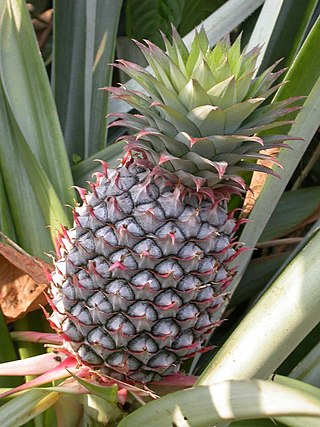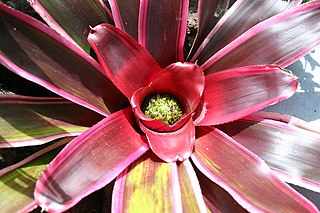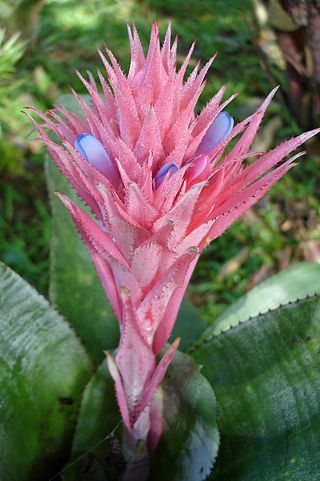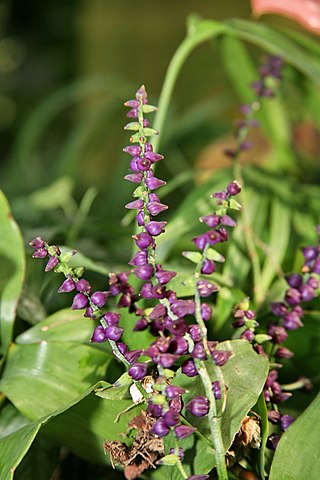
The Bromeliaceae are a family of monocot flowering plants of about 80 genera and 3700 known species, native mainly to the tropical Americas, with several species found in the American subtropics and one in tropical west Africa, Pitcairnia feliciana.

Neoregelia is a genus of epiphytic flowering plants in the family Bromeliaceae, subfamily Bromelioideae, native to South American rainforests. The genus name is for Eduard August von Regel, Director of St. Petersburg Botanic Gardens in Russia (1875–1892).

Vriesea is a genus of flowering plants in the botanical family Bromeliaceae, subfamily Tillandsioideae. The genus name is for Willem Hendrik de Vriese, Dutch botanist, physician (1806–1862). Its species are widespread over Mexico, Central America, South America and the West Indies.

Aechmea is a genus of flowering plants in the family Bromeliaceae. The name comes from the Greek aichme, meaning "spear". Suggested pronunciations include EEK-me-ə and eek-MEE-ə. Aechmea comprises eight subgenera and around 250 species distributed from Mexico through South America and the Caribbean. Most of the species in this genus are epiphytes.

Araeococcus is a genus of the botanical family Bromeliaceae, subfamily Bromelioideae. It is native to northern South America, Central America and Trinidad.

Canistrum is a genus of plants in the family Bromeliaceae, subfamily Bromelioideae.

Cryptanthus is a genus of flowering plants in the family Bromeliaceae, subfamily Bromelioideae. The genus name is from the Greek cryptos (hidden) and anthos (flower). The genus formerly had two recognized subgenera: the type subgenus and subgenus HoplocryptanthusMez which has been raised to the separate genus Hoplocryptanthus. All species of this genus are endemic to Brazil. The common name for any Cryptanthus is "Earth star".

Aechmea nudicaulis is a bromeliad species in the genus Aechmea, which is often used as an ornamental plant. This species is native to Central America, the West Indies, central and southern Mexico, and northern and central South America.

Wittmackia is a genus of flowering plants in the family Bromeliaceae.

Pitcairnia is a genus of plants in the family Bromeliaceae, subfamily Pitcairnioideae. It was named for William Pitcairn, Scottish physician and gardener (1711–1791). The genus Pitcairnia ranks as the second most prolific of the bromeliad family. They are most abundant in Colombia, Peru and Brazil, but can also be found in areas from Cuba and Mexico south to Argentina. One species, Pitcairnia feliciana, is found in tropical West Africa and is the only member of the family Bromeliaceae not native to the Americas.

Orthophytum is a genus in the plant family Bromeliaceae, subfamily Bromelioideae.

Ronnbergia is a genus in the plant family Bromeliaceae, subfamily Bromelioideae. Native to South and Central America, this genus was named for Auguste Ronnberg, Belgian Director of Agriculture and Horticulture in 1874.

Lymania is a genus in the plant family Bromeliaceae, subfamily Bromelioideae. The genus was established in 1984 to "unite furrowed or winged species from Aechmea subgenera Lamprococcus, Araeococcus and Ronnbergia."

Karawata depressa is a species of flowering plant in the family Bromeliaceae, endemic to Brazil. It was first described by Lyman Bradford Smith in 1941 as Aechmea depressa.

Karawata gustavoi is a species of flowering plant in the family Bromeliaceae, endemic to northeastern Brazil. It was first described in 2001 as Aechmea gustavoi.

Karawata multiflora is a species of flowering plant in the family Bromeliaceae, endemic to northeastern Brazil. It was first described by Lyman Bradford Smith in 1937 as Aechmea multiflora.

Karawata saxicola is a species of flowering plant in the family Bromeliaceae, native to southeastern Brazil, in the states of Espírito Santo and Rio de Janeiro. It was first described by Lyman Bradford Smith in 1950 as Aechmea saxicola.
Karawata hostilis is a species of flowering plant in the family Bromeliaceae, endemic to Brazil. It was first described in 1972 as Aechmea hostilis.
Karawata nigribracteata is a species of flowering plant in the family Bromeliaceae, native to Brazil. It was first described in 2014 as Aechmea nigribracteata.

Karawata prasinata is a species of flowering plant in the family Bromeliaceae, native to Brazil. It was first described in 2015 as Aechmea prasinata.


















